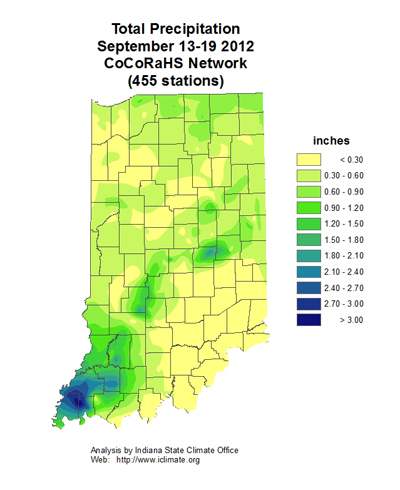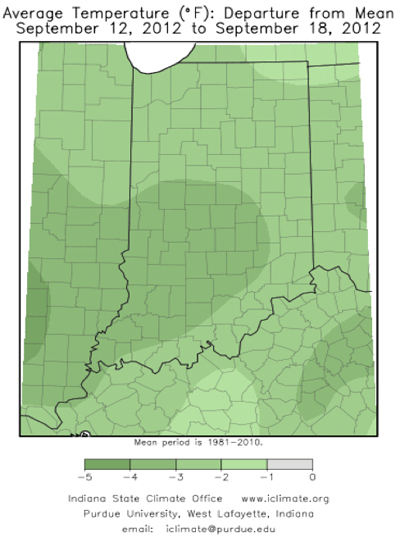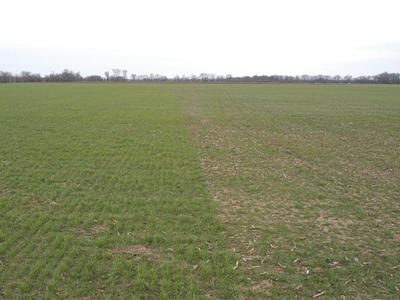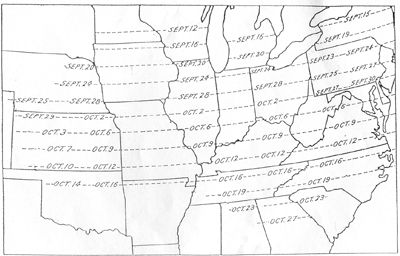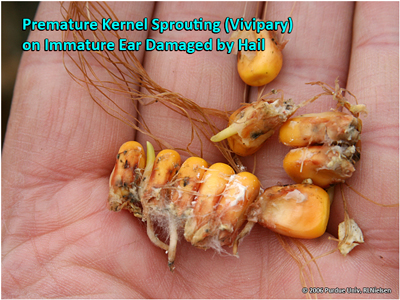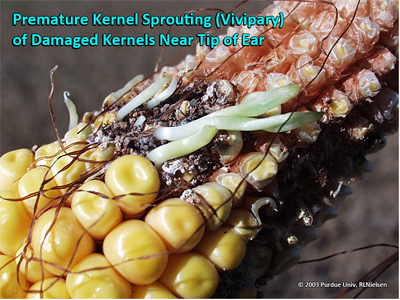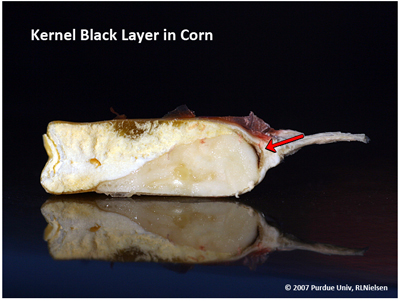Pest & Crop Newsletter, Entomology Extension, Purdue University
Conditions are Favorable for a Strong Return of Hessian Fly – (Brandi Schemerhorn)-
The Hessian fly is present in wheat growing areas throughout the US, including Indiana. The Hessian fly can survive on alternative grass hosts, and will be waiting to infest a field the next time wheat is planted. When the opportunity presents itself, there is potential for a rapid increase of fly populations as a result of weather conditions or cropping practices that favor survival of eggs and young larvae in the fall. Many fields throughout the US are already empty due to the nationwide drought that occurred this year. It is imperative that we do not jump the gun and still practice following the fly-free date and plowing fields before planting wheat.
Following the fly-free date. Much of the fall fly population can be avoided by planting after the fly-free date. A low fall infestation often goes unnoticed due to the tillering of the wheat plant The fly-free date is of key importance, even if you plan to use the wheat only for cattle. It is tempting given the open fields early in the season to plant wheat early. This could lead to disastrous consequences. The fly-free date is our main protection to avoid a subsequent infestation by the spring brood. Additionally, it has been shown that following the fly-free date helps reduce other wheat disease problems and reduces winter-kill from excessive growth.
Plowing fields after wheat harvest destroys the fly. The Hessian fly passes the summer in the stubble of the current wheat crop. Volunteer wheat germinates and begins growing just in time for the fall emergence of the Hessian fly. These plants are readily infested resulting in a rapid build-up of the population. Removal of volunteer wheat before the emergence of the fall brood greatly reduces the insect reservoir for a spring infestation.
Test plots showing resistant (left) and susceptible (right) wheat
Map showing approximate dates for planting wheat to avoid first generation Hessian fly damage
![]()
Click here for the Blacklight Trap Catch Report
Premature Corn Kernel Sprouting (aka Vivipary) – (Bob Nielsen) -
Vivipary, the premature germination or sprouting of corn kernels on the cob prior to harvest, is not a common problem in Indiana but sometimes can be serious enough to warrant attention from growers. Technically, the fact that corn kernels have the ability to germinate and develop into seedlings is not odd. Yet, when such sprouting occurs while immature or mature kernels are still attached to the cob, we consider it odd and assign a fancy name to it to reinforce the fact that we consider it odd. On the rare occasion when viviparous germination occurs throughout a field to a large enough degree, overall grain quality can deteriorate enough to cause problems with drying and storage of grain. Another consequence of the increase in the percentage of “broken corn and foreign material” in affected grain delivered to the elevator is that it may result in significant grain price discounts to the grower.
Germination of mature corn kernels on the cob prior to harvest is most likely to occur when reasonably dry kernels ( less than about 20 percent grain moisture content) are re-wetted, especially when temperatures are warm. Consequently, the common situation for vivipary to occur is the combination of dry grain, upright ears on the plants, and rainfall that is “captured” by the husk leaves of the upright ears. The result can be sprouted kernels near the butt of the ear. The likelihood of viviparous germination occurring on upright ears with grain at higher moisture contents is typically much less than for dryer grain.
Another common situation where vivipary occurs is when ears are lying on or near the soil surface due to severe stalk breakage or lodging. That proximity of the ears to moist soil allows a similar re-wetting of the kernels and dramatic germination of kernels on the cob much like we would typically see the following spring............. at which point we no longer use the fancy “vivipary” term, but simply refer to it as “volunteer corn”.
It is generally accepted that germination of kernels typically does not occur prior to physiological maturity (aka black layer). The reasons for this are related to hormonal balances within the kernels; apparently the balance between gibberellin and abscisic acid in particular. In fact, this balance seems to determine whether seed development and maturation continues or seed germination is enabled (White et. al., 2000).
The concept of a balance among hormones playing a vital role in determining whether seed will continue developing or whether it germinates may also help explain why vivipary often occurs in immature kernels on ears physically damaged by hail, birds, or ear molds. The speculation is that the physical damage to immature kernels may disrupt the normal balance among the regulatory hormones and allows for the germination of the damaged kernels. Some ear molds also produce gibberellic acid that can also disrupt the balance of hormones and stimulate germination.
Considerations for reducing the consequences of poor quality grain that can result from significant levels of vivipary include timely harvest of severely-affected fields, drying grain at higher temperatures to prevent further growth of the young seedlings, screening the grain prior to storage to reduce the amount of damaged grain and seedling tissue, and removing several loads from a full bin (aka “coring” the bin) to reduce the high concentration of broken corn and foreign material that typically accumulates in the center of a bin during filling.
Related References
Anonymous. Pioneer Hi-Bred Int’l. Premature Germination of Corn Kernels. Pioneer Hi-Bred International. <http://tinyurl.com/9hjsjuv> [tiny URL created Sep 2012].
Neill, S.J., Horgan, R. & Rees, A.F., 1987. Seed development and vivipary in Zea mays L. Planta, 171(3), pp.358–364.
White, C.N. et. al., 2000. Gibberellins and Seed Development in Maize. I. Evidence That Gibberellin/Abscisic Acid Balance Governs Germination versus Maturation Pathways. Plant Physiology, 122(4), pp.1081 –1088.
Wiebold, Bill. 2009. Wet Weather Can Cause Seeds to Sprout before Harvest. Integrated Pest & Crop Management Newsletter, Univ of Missouri. <http://ipm.missouri.edu/IPCM/2009/11/Wet-Weather-Can-Cause-Seeds-to-Sprout-before-Harvest>. [URL accessed Sep 2012].
Premature kernel sprouting (Vivipary) on mature, upright ear of corn
Premature kernel sprouting (vivipary) on ear of severely lodged corn plant
Premature kernel sprouting (Vivipary) on immature ear damaged by hail
Premature kernel sprouting (Vivipary) on immature ear damaged by hail
Premature kernel sprouting (Vivipary) of damaged kernels near tip of ear
![]()
Interpreting Corn Hybrid Maturity Ratings – (Bob Nielsen) -
Hybrid maturity ratings have always been a sort of mystery to farmers and consultants alike. One factor that contributes to the mystery is that your definition of “maturity” may not be the same as my definition. By that, I mean that there is no accepted standard method for assigning relative hybrid maturity values within the seed industry.
Agronomists usually refer to “maturity” as that point in time at the end of the grain filling period when maximum weight per kernel has occurred. The usual term for this is “physiological maturity” and is often associated with the development of the black layer at the tip of the mature kernel.
Grain moisture content at the onset of physiological maturity typically occurs within the range of 25 to 35 percent, though black layer can occur at grain moistures as wet as 40 percent. Grain moisture at physiological maturity varies year to year depending on growing conditions and can vary hybrid to hybrid.
Kernel black layer in corn
Another definition of “maturity” is that point in time after physiological maturity when a hybrid can be safely harvested with minimal harvest loss, either by kernel loss or kernel damage. My term for this is “harvest maturity” and is usually associated with a grain moisture content of around 25 percent.
The most commonly used method for assigning hybrid maturity ratings (i.e., “days to maturity”) is based on comparisons among hybrids near the time of “harvest maturity”, with the assumption that grain moisture loss in the field is about 0.5 percentage point per day. Consequently, two days of field drying equals 1 “day” of relative hybrid maturity (0.5 x 2 = 1), four days of field drying equals 2 “days” of relative hybrid maturity (0.5 x 4 = 2), etc.
For example, if the grain moisture content of a new hybrid is two percentage points wetter than that of a “standard” hybrid with an assigned relative maturity value of 110, the new hybrid is assigned a relative maturity value of 114 (two points of moisture divided by 0.5 point per day moisture loss).
Historically, folks have added the word “days” to this hybrid maturity rating value (i.e., 114-day hybrid), but it is important to recognize that this value does not refer to actual calendar time between planting and harvest maturity. Consequently, traditional relative maturity ratings of hybrids are of little help in determining whether a hybrid will safely mature before a killing fall frost.
The other common method for assigning relative hybrid maturities is based on the thermal time between planting and physiological maturity. Terms used to describe thermal time include “growing degree days” (GDD), “growing degree units” (GDU) and “heat units” (HU). Growing degree day values represent the amount of heat accumulated over a period of time. Since this method depends on actual measurement of thermal time, there is no need to compare hybrids in order to assign maturity rating values. In other words, the maturity rating for an individual hybrids stands on its own. Common values for such maturity ratings range from about 2500 (earlier maturity hybrids) to 2800 (later maturity) for hybrids commonly grown in Indiana.
The relationship between “days to maturity” and GDD ratings is close but not always exact because each is based on a different definition of “maturity”, the difference being the time period between physiological and harvest maturity. If two hybrids require the same number of GDD to reach physiological maturity, but field dry at different rates, they may be assigned the same GDD hybrid rating, but different “days to maturity” ratings. Neither method is perfect, either, because of the influences of climatic conditions and plant stress on the grain maturation process.
Another “fly in the ointment” is the fact that there are no agreed upon standards within the seed industry for the application of either method for assigning relative hybrid maturities. Minor differences in methodologies among seed companies often result in the farmer’s frustration in comparing maturity values among different brands of hybrids.
Exception: By law, the labeled relative maturity of commercial corn hybrids sold in Minnesota must be within three days of the actual relative maturity as determined by comparative trials conducted by the Minnesota Ag. Expt. Station.
Unfortunately, the lack of industry standardization can make it difficult for growers who need to make a hybrid maturity decision for late planting situations and want to base that decision on the remaining available GDDs. Fortunately, at least one of the larger seed corn companies clearly states that their hybrids are rated according to GDD accumulations from planting to kernel black layer. Consequently, one can compare their relative hybrid maturity ratings against their growing degree day ratings to kernel black layer and develop a mathematical formula for predicting the GDD requirement of a hybrid using its relative hybrid maturity rating (Fig. 2)
Disclaimer: Reference to any seed company in this article does not constitute an endorsement of said seed company by me or Purdue University. The public availability of said seed company’s hybrid maturity ratings simply facilitates the mathematical modeling described in this article.
One can use this relationship to estimate the GDDs from planting to black layer for other companies’ hybrids of similar relative maturities. For example, if the relative maturity of a hybrid is known to be comparable to a 110-day (CRM) Pioneer™ brand hybrid maturity, then Figure 1 suggests that the GDDs from planting to black layer would be approximately 2650. With this estimate in hand, growers can then begin the process of determining safe hybrid maturities for late planting situations.
Kernel black layer in corn
Related References
Dwyer, L.M., Stewart, D.W., Carrigan, L., Ma, B.L., Neave, P., Balchin, D., 1999. Guidelines for Comparisons among Different Maize Maturity Rating Systems. Agron. J. 91, 946–949.
Nielsen, R.L. (Bob). 2008. Grain Fill Stages in Corn. Corny News Network, Purdue Extension. [online] <http://www.kingcorn.org/news/timeless/GrainFill.html> [URL accessed Sep 2012].
Nielsen, R.L. (Bob). 2010. Heat Unit Concepts Related to Corn Development. Corny News Network, Purdue Extension. [online] <http://www.kingcorn.org/news/timeless/HeatUnits.html> [URL accessed Sep 2012].
Nielsen, R.L. (Bob). 2010. Hybrid Selection: Where’s the Beef? Corny News Network, Purdue Extension. [online] <http://www.kingcorn.org/news/timeless/HybridSeln.html> [URL accessed Sep 2012].
Nielsen, R.L. (Bob). 2011. “Safe” Hybrid Maturities for Delayed Corn Planting in Indiana. Corny News Network, Purdue Extension. [online] <http://www.kingcorn.org/news/articles.11/SafeHybridMaturities-0426.html> [URL accessed Sep 2012].
Peterson, R.H., and D.R. Hicks. 1973. Minnesota relative maturity rating of corn hybrids. Agron. No. 27. Univ. of Minn. Agric. Ext. Serv., St. Paul.
State of Minnesota. 2012. Minnesota Seed Law and Rules. Minnesota Dept Ag, Plant Protection Division, Seed Unit. [online] <http://www.mda.state.mn.us/licensing/licensetypes/~/media/Files/licensing/seed/seedlaw.ashx> [URL accessed Sep 2012].
Sutton, L.M., Stucker, R.E., 1974. Growing Degree Days to Black Layer Compared to Minnesota Relative Maturity Rating of Corn Hybrids. Crop Sci. 14, 408–412.
